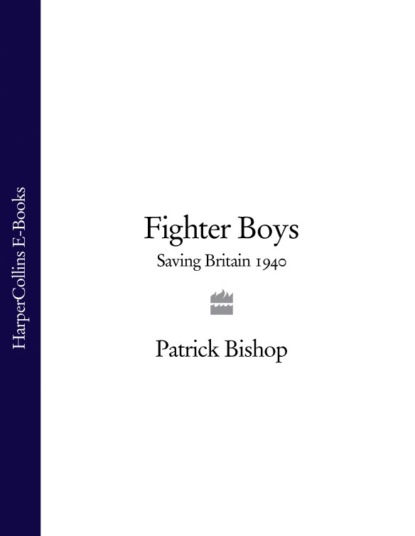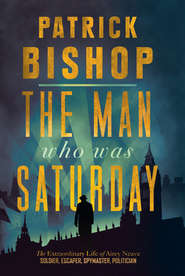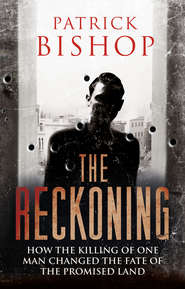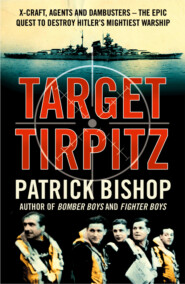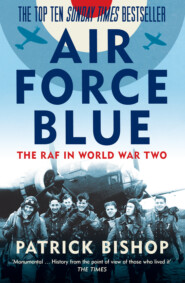По всем вопросам обращайтесь на: info@litportal.ru
(©) 2003-2024.
✖
Fighter Boys: Saving Britain 1940
Настройки чтения
Размер шрифта
Высота строк
Поля
The Hurricane made its first flight on 6 November 1935 at Brooklands in Surrey. Hawker’s chief test pilot, George Bulman, a small, bald, ginger-moustached extrovert who had flown with the RFC in the war, was in the cockpit. The prototype had been developed in great secrecy. When the tarpaulins were stripped away and the hangar doors opened, there were murmurs of surprise. It was painted silver, which emphasized the sleekness of its low, humped lines and the sculptured way the rounded wings fitted beautifully flush to the fuselage below the neat, narrow cockpit. It was big, bigger than any existing fighter, and at more than 6,000 pounds very heavy. It seemed unlikely that a single engine could get it off the ground. Bulman, in overalls and flying helmet, approached the machine and vaulted into the cockpit watched by Camm and other Hawker executives, who stood at the edge of the damp field, smoking nervously. The Hurricane bumped away into the distance then turned into the wind. The rumble of the Rolls-Royce engine deepened into a roar. The machine moved forward, gathering speed, but slowly, so that some thought Bulman would not get airborne before he ran out of field. At the last moment the Hurricane left earth in an abrupt bounding movement and climbed steeply. The spectators watched the undercarriage retract and the muscular shape dwindle into the distance until it disappeared and the sound of the engine faded. Half an hour later the reassuring drone was heard again. Bulman performed a perfect three-point landing and taxied over to where Camm was waiting to report the flight had been ‘a piece of cake’.
(#litres_trial_promo)
The Spitfire, the first prototype of which flew in March 1936, was a more modern design, all metal with a monocoque fuselage and thin, elliptical wings, the more sophisticated offspring of the Supermarine C6. It had the same Merlin engine as the Hurricane and carried the same guns, but at 5,180 pounds it weighed 1,000 pounds less and went 30 m.p.h. faster. The name was proposed by the chairman of Vickers, Sir Robert McLean, whose company had taken over Supermarine. R. G. Mitchell, whose designs carried the machine through its various evolutions to become the most beautiful and efficient fighter of its era, was not impressed. ‘Just the sort of bloody silly name they would choose,’ he is reported to have said on hearing the decision.
(#litres_trial_promo) But in the propaganda film of his life The First of the Few, which appeared in 1942, he is portrayed as devising the name himself: ‘A curious sort of bird…a bird that spits out death and destruction…a Spitfire bird.’
The orders came quickly, with the Air Ministry ordering 600 Hurricanes and 310 Spitfires in the summer of 1936. The accelerated pace reflected alarm that the next war might come sooner than expected. Preparations at every level speeded up as successive intelligence reports, and the Germans’ own boasts, suggested that Britain’s reluctant rearmament programme was insufficient either to deter or defend.
The sense of urgency, and the rapid twists and turns of circumstance, were evident in the brevity of the shelf-lives of the schemes that succeeded Scheme A, as both government and the Air Ministry tinkered with the plan to take account of a situation that always seemed to be changing for the worst. Only one scheme, Scheme F, approved by the cabinet in February 1936, was implemented as planned, coming to fruition in March 1939.
But the expansion was real. From 1935 forty-five new air stations were ordered to be built, most of which were finished by the time war came. Scheme C, which was approved in May 1935, envisaged 123 home squadrons as opposed to the 76 designated in Scheme A. That meant recruiting 1,500 pilots in the next two years. Altogether the RAF was to increase fivefold between 1934, when there were 31,000 officers and men, and the outbreak of war, when the service had an actual strength of 118,000 backed by about 45,000 reserves.
The Air Minister, Lord Swinton, inherited Trenchard’s system of short-service officers, who since the early 1920s had supplemented and outnumbered the cadre of permanent RAF officers. He intensified links with public schools, attracting 1,700 entrants. A further 800 pilots were found among RAF non-commissioned officers. Australia, Canada, New Zealand and South Africa were all asked to contribute men. The number of auxiliary squadrons increased from eight to twenty in the run-up to the war. But more radical measures were needed to satisfy the new demand and, equally important, to provide a reserve.
A pool of pilots would be essential to replace the dead and wounded once the fighting started. The Director of Training at the Air Ministry, Air Commodore A. W. Tedder, a Trenchard protégé who had inherited some of his briskness of thinking, conceived the idea of a ‘Citizen Air Force’. It was to be democratic in character, and linked to a locality, but to the factories, offices and avenues and crescents of semi-detached homes in the new estates springing up around towns rather than to the shires to which the army’s territorial units attached themselves. The Air Ministry added that the new force should be ‘open…to the whole middle class in the widest sense of that term, namely the complete range of the output of the public and secondary schools’. Given its nature it was felt ‘inappropriate to grade the members on entry in as officers or airmen according to their social class’. Everyone therefore started out the same, as airmen under training, with commissions being awarded later on ability and leadership qualities.
(#litres_trial_promo) The Royal Air Force Volunteer Reserve, as it was christened, started in August 1936. It gave young men of between eighteen and twenty-five the chance to learn to fly, at no cost, in their spare time. They received £25 per annum and were expected to attend an annual fifteen-day flying course at one of the training centres set up around the country. The aim had been to take on 800 a year over three years, but the potential number of recruits was much greater and by the spring of 1939 there were 2,500 RAFVR pilots in training. When war broke out, 310 had already entered Fighter Command.
The second half of the 1930s saw the RAF transformed from a small, professional élite into a mass force with the potential to fight a major war. The question of how it would go about doing that was not finally resolved until the end of 1938, when the great strategic conundrum of bombers or fighters, offence or defence, was settled, at least for the first stage of the coming war. In December that year the balance shifted decisively in favour of fighters and ‘close defence’. The change was initiated not by the air force itself but by the government. Despite radar and the advent of the Hurricane and Spitfire, the Air Ministry pressed for parity with the German bomber force. But the government decided this was no longer possible within the time available. The goal had always been unrealistic. Britain was a democracy, reacting wearily to the threat of a war it had no wish to fight. Rearmament had been late and grudgingly paid for, with the aircraft factories still operating at peacetime levels of production. Germany was a dictatorship, heading at full speed and with no concern for cost towards a conflict of its own making. Britain was not going to catch up before the war was launched. It was the minister in charge of defence coordination, Sir Thomas Inskip, who forced the air force to accept the change in strategic thinking. In a memo to Swinton of 7 December he stated the new thinking crisply:
I cannot take the view that our Air Force must necessarily correspond in numbers and types of aircraft with the German Air Force. I cannot, therefore, persuade myself that the dictum of the Chief of the Air Staff that we must give the enemy as much as he gives us is a sound principle. I do not think it is the proper measure of our strength. The German Air Force…must be designed to deliver a knock-out blow within a few weeks of the outbreak of war. The role of our Air Force is not an early knock-out blow – no one has suggested that we can accomplish that – but to prevent the Germans from knocking us out.
(#litres_trial_promo)
The inference was clear. For the time being at least the emphasis would be on defence and making any German attack on Britain too painful to sustain. Despite the strenuous opposition of the Air Ministry and RAF senior staff, the Cabinet backed Inskip’s view. The next years would belong to the fighters, and those who flew them.
3 ‘Free of Boundaries, Free of Gravity, Free of Ties’ (#ulink_24fe973e-638b-5cb9-bafc-ed0e85abd929)
The great RAF expansion gave thousands of young men the chance to realize an ambition that had seemed remote and probably unattainable when they first conceived it. That flying was possible was still a relatively novel idea. For most people in the world the thought that they would ever actually do so themselves was fantastical. The banality of aviation has hardened our imaginations to the fascination it excited in the years between the wars. Once, in Uganda in the 1980s, I was at a remote airstrip when a relief plane took some adolescent boys for a joyride. It was the first time they had been in an aeroplane. When they landed their friends ran out to examine them, as if they expected them to have been physically transformed by the experience.
So it was, or nearly so, in the inter-war years. ‘Ever been up?’ people would ask each other at the air displays that attracted hundreds of thousands in Britain in the 1920s and 1930s. Those who could say ‘yes’ were admired for their daring, their worldliness, their modernity. The men and women who flew the beautiful treacherous machines were exalted and exotic. In the eyes of many, their courage and skill put them at the apex of human evolution.
Aviators were as popular as film stars. Record-breaking feats of speed, distance and endurance filled the papers. Men were the most avid readers of these stories, young men and boys. Almost every pilot who fought in Fighter Command in 1940 fell for flying early. Their interest flared with the intensity of a great romance. For some, the first magical taste came with a ten-minute flip in the rear cockpit of one of the rickety machines of the flying circuses that hopped around the country, setting up on racecourses or dropping in at resort towns. The most famous was led by Alan Cobham, a breezy entrepreneur who was knighted for pioneering flights across Asia. Billy Drake was sixteen years old, on holiday from his boarding school in Switzerland, when the circus arrived to put on a display close by his father’s golf club near Stroud. It was half a crown to go up. Drake was already intoxicated with aviation, but his parents tried to dissuade him, partly because flying seemed a dead end for a middle-class boy, but also because they feared for his safety. The brief hop over the Gloucestershire fields was enough to set the course of his early life. ‘When I got down,’ he remembered many years later, ‘I knew that this was it.’
(#litres_trial_promo)
Pete Brothers watched aeroplanes in the skies around his home in Lancashire, where his family owned a firm supplying chemicals to the food and pharmaceutical industries. In his spare time he made model aeroplanes. His family were wary of his enthusiasm. In 1936, on his sixteenth birthday, he was given flying lessons at the Lancashire Aero Club in the hope that the draughty, dangerous reality of flying would cool his ardour. ‘My father said, “You’ll get bored with it, settle down and come into the family business.” But I didn’t. I went off and joined the air force.’ He took his father flying and he, too, became ‘flat-out keen’.
(#litres_trial_promo)
Sometimes, unwittingly, parents planted the germ themselves. Dennis David was seven years old and on holiday in Margate when, ‘as a special treat, my mother and I went up in an Avro 504 of the Cornwall Aviation Company. Though I was surprised by the din, this…sowed a seed inside me.’
(#litres_trial_promo)
Just the sight of an aeroplane could be enough to ignite the passion. James Sanders got up at five one morning, in July 1933, at the villa in Genoa where his wealthy archaeologist father had moved the family, to watch a formation of twenty-four Savoia Marchetti seaplanes, led by Italo Balbo, the head of the Italian air force, heading west on a propaganda visit to the United States, and felt two certainties. ‘There was going to be a war, there was no question about it, and I was going to be in the air force.’
(#litres_trial_promo)
Throughout the inter-war years, all around the country, many a flat, boring pasture was transformed into an airfield and became an enchanted domain for the surrounding schoolboys. On summer evenings Roland Beamont would cycle from his prep school in Chichester to the RAF station at Tangmere, climb on to his bicycle to see over the hedge and watch 11 Squadron and 43 Squadron taking off and landing in their Hawker Furies. From the age of seven, when he had been taken up by a barnstorming pilot, he had been entranced with flying. Watching the silver-painted biplanes, the sleekest and fastest in the air force, he decided he ‘wanted more than anything else to be on fighters’.
(#litres_trial_promo) Twelve years later he was in the middle of the Battle of Britain, flying Hurricanes from the same aerodrome.
First encounters with aeroplanes and airmen sometimes had the quality of a dream. Bob Doe, a shy schoolboy, was walking home after classes to his parents’ cottage in rural Surrey when ‘an RAF biplane fighter…force-landed in a field close to the road. I was able to walk around it, touch it and feel what was to me [the] beginning of the mystery of aviation.’
(#litres_trial_promo) Thousands of miles away on the other side of the world, near the town of Westport in the Southern Alps of New Zealand, a small, restless boy called Alan Deere had experienced the same revelation. While playing near his father’s farm he heard the note of an engine in the sky, looked up and saw a tiny silver machine. He had heard of aeroplanes but never seen one. ‘The fact that one was now overhead seemed unbelievable. Where did it come from? Who was the pilot? Where was it going to land?’ After the aircraft put down on a beach, he and his friends stood ‘for long hours…and gazed in silent wonder at the aeroplane until eventually our persistence was rewarded by an invitation to look into the cockpit. There within easy reach was the “joystick”…the very sound of the word conjuring up dreams of looping and rolling in the blue heavens.’ As he studied the instruments ‘there gradually grew within me a resolve that one day I would fly a machine like this and perhaps land on this very beach to the envy and delight of my boyhood friends.’
(#litres_trial_promo)
Almost all of these recorded episodes feel like encounters with fate. Brian Kingcome was making his languid progress through another term at yet another boarding school when, one sunny afternoon, ‘there came the drone of an aero-engine overhead – not a common sound in the mid 1930s – and a small aircraft circled the school a couple of times at roof-top height. The whole school rushed out to watch spellbound as the tiny machine throttled back and, in that lovely, burbling, swooshing silence that follows the throttling back of an old fashioned aero-engine, glided in to land in the park in front of the house.’ The pilot who emerged, nonchalant and romantic in flying helmet and silk scarf, was a young man, four years Kingcome’s senior, whom he had known at one of the several previous schools his mother’s whims had directed him to.
‘Is there a Brian Kingcome here?’ he asked. ‘Have I come to the right place?’
He had, and there was. My stock soared…Basking in the gaze of many envious eyes, I climbed aboard and a moment later found myself for the first time in a world I had never dreamed could exist – a world free from the drag of earth’s umbilical cord, free to climb, swoop and dive, free of boundaries, free of gravity, free of ties, free to do anything except stand still.
(#litres_trial_promo)
Whatever their differences of background, all these boys were children of their time. Their enthusiasms were stoked by what they read in the illustrated papers, aimed at the youth market, that sold in millions. These, just as others would do a generation later, leant heavily on the preceding war for their material, and particularly on the doings of the heroes who had emerged from the RFC. The anonymous editors of the comics of the era, with their almost infallible comprehension of the young male psyche, recognized at once the charge that old-fashioned swashbuckling married to modern technology would carry. The example of the first fighter aces fixed itself in the imaginations of a generation being born just as they had met their deaths. Even at nineteen the thoughts of Geoffrey Page as he left his public school to go up to study engineering at London University ‘were boyishly clear and simple. All I wanted was to be a fighter pilot like my hero, Captain Albert Ball. I knew practically all there was to know about Albert Ball; how he flew, how he fought, how he won his Victoria Cross, how he died. I also thought I knew about war in the air. I imagined it to be Arthurian – about chivalry…death and injury had no part in it.’
(#litres_trial_promo)
Yet the most popular chronicles of the air war were remarkably frank about what was entailed. The deterrent effect appears to have been minimal. Perhaps Fighter Command’s single most effective recruiting sergeant was Captain James Bigglesworth, created by W. E. Johns, who had flown with the RFC in the First World War and whose stories began to appear in Popular Flying magazine in 1932. The first novel, The Camels Are Coming, was published the same year. Biggles seems unattractive now; cold, driven by suppressed anger, a spoilsport and a bit of a bully. He was a devastatingly romantic figure to the twelve- and thirteen-year-olds who went on to emulate him a few years later. Johns introduced them to a
slight fair-haired, good-looking lad still in his teens but [already] an acting flight commander…his deep-set eyes were never still and held a glint of yellow fire that somehow seemed out of place in a pale face upon which the strain of war, and sight of sudden death, had already graven little lines…He had killed six men during the past month – or was it a year? – he had forgotten. Time had become curiously telescoped lately. What did it matter, anyway? He knew he had to die some time and had long ago ceased to worry about it.
Many of the stories were based on real events, some relating to Mannock, who appears disguised as ‘Mahoney’. Johns made no attempt to hide the grisliness of the business, emphasizing the man-to-man nature of primitive air fighting. In one story he repeats with approval von Richthofen’s maxim that ‘when attacking two-seaters, kill the gunner first’, and goes on to describe his hero doing just that. ‘Pieces flew off the green fuselage, and as he twisted upwards into a half roll Biggles noticed that the enemy gunner was no longer standing up. “That’s one of them!” he thought coolly. “I’ve given them a bit out of their own copy-book.”’
(#litres_trial_promo) In another, Biggles notes an ‘Albatros, wrapped in a sheet of flame…the doomed pilot leaping into space even as he passed’.
(#litres_trial_promo)
It is not only Germans who die. Getting killed is presented as almost inevitable. An important and enduring message, one the young readers took to heart, was that there was no point dwelling on it. ‘One of the most characteristic features of the Great War,’ Johns wrote in the Foreword to Biggles in France, ‘was the manner in which humour and tragedy so often went hand in hand. At noon a practical joke might set the officers’ mess rocking with mirth. By sunset, or perhaps within the hour, the perpetrator of it would be gone for ever, fallen to an unmarked grave in the shellholes of No Mans Land.’
(#litres_trial_promo)
The Biggles stories are practically documentary in their starkness, as good a guide to the air war over the trenches as the non-fictional memoirs. Their audiences were absorbed and inspired by them. They changed lives. Reading them reinforced Pete Brothers’s decision to seek a short-service commission in the RAF. He found them ‘beautiful stories that enthralled me and excited me and made me want to emulate them’. At the Lancashire Aeroclub before taking up a short-service commission in January 1936, he had been pleased to find his instructor had been a Sopwith Camel pilot in the war.
(#litres_trial_promo)
Cinematic portrayals of the air were equally frank. The most successful was Dawn Patrol, starring Errol Flynn, David Niven and Basil Rathbone, which came out in 1938. The 59th Squadron is based on a sticky sector of the Western Front. Sixteen men have gone in a fortnight. Replacements arrive, fresh from a few weeks at flying school. Orders to send them up against hardened Germans come by telephone from senior officers, comfortably quartered miles behind the lines. New names are chalked up on the duty blackboard to be wiped off within an hour. Kit-bags are returned home without ever being unpacked. The Daily Express praised the film’s ‘lack of false sentiment or mock heroics’ and called it ‘one of the best and bitterest melodramas about men and planes’. It was a box-office hit and was seen, often several times, by hundreds of the pilots who fought in 1940. No one was put off. It was the glamour, camaraderie and romance of flying that pulled them back to the local fleapits, not the message of waste and futility. By this time every young man in Britain was facing a prospect of early extinction. Dying in the air might be awful, but it was better than dying on the ground.
With the expansion programme, thousands of young men were now being given a choice in how they would fight the next war. Before it began, the RAF recruited annually about 300 pilots and 1,600 airmen. Between 1935 and 1938 the average RAF intake was 4,500 and 40,000 airmen and apprentices. Air Ministry officials appealed directly to schools for recruits and advertised in the flying magazines and popular newspapers the young men they were looking for might be expected to read. One that appeared on the front page of the Daily Express, adorned by a drawing of three Hurricanes, promised ‘the life is one that will appeal to all men who wish to adopt an interesting and progressive career…leave is on a generous scale…applicants must be physically fit and single but no previous flying experience is necessary’. Pay, in cash and kind, was set at between £340 and £520 a year. A £300 gratuity was payable after four years’ service, or £500 after six years. Age limits were set between seventeen and a half and twenty-eight. The educational qualification was school certificate standards, although ‘an actual certificate is not necessary’.
Pat Hancock, a mechanically minded eighteen-year-old from Croydon, was at Wimbledon Technical College when he saw an advertisement in the Daily Express. ‘The ministry – bless it – was offering commissions to suitable young gentlemen – four years, and at the end if you survived you got a magnificent lump sum of £300, which was really a lot in those days. I pounced on it and sweet talked my father and mother into allowing me to apply.’
(#litres_trial_promo)
Parental permission was needed if the applicant was under twenty-one, and many pilots seem to have faced, at first at least, family opposition. Flying was undeniably dangerous. In an era when men chose a profession, trade or occupation and tended to stick with it for the rest of their working life, it offered a very uncertain career. Despite popular enthusiasm, commercial aviation had been slow to expand. Air travel was confined to the rich. RFC pilots who hoped to make their livings flying in peacetime were mostly disappointed. Arguments were needed to overcome the objections. Billy Drake misunderstood the terms and thought the RAF would pay him an annuity of £300, a detail which persuaded his parents to grant their approval.





